Charles E W Bean, Diaries, AWM38 3DRL 606/273/1 - 1918 - 1937 - Part 4
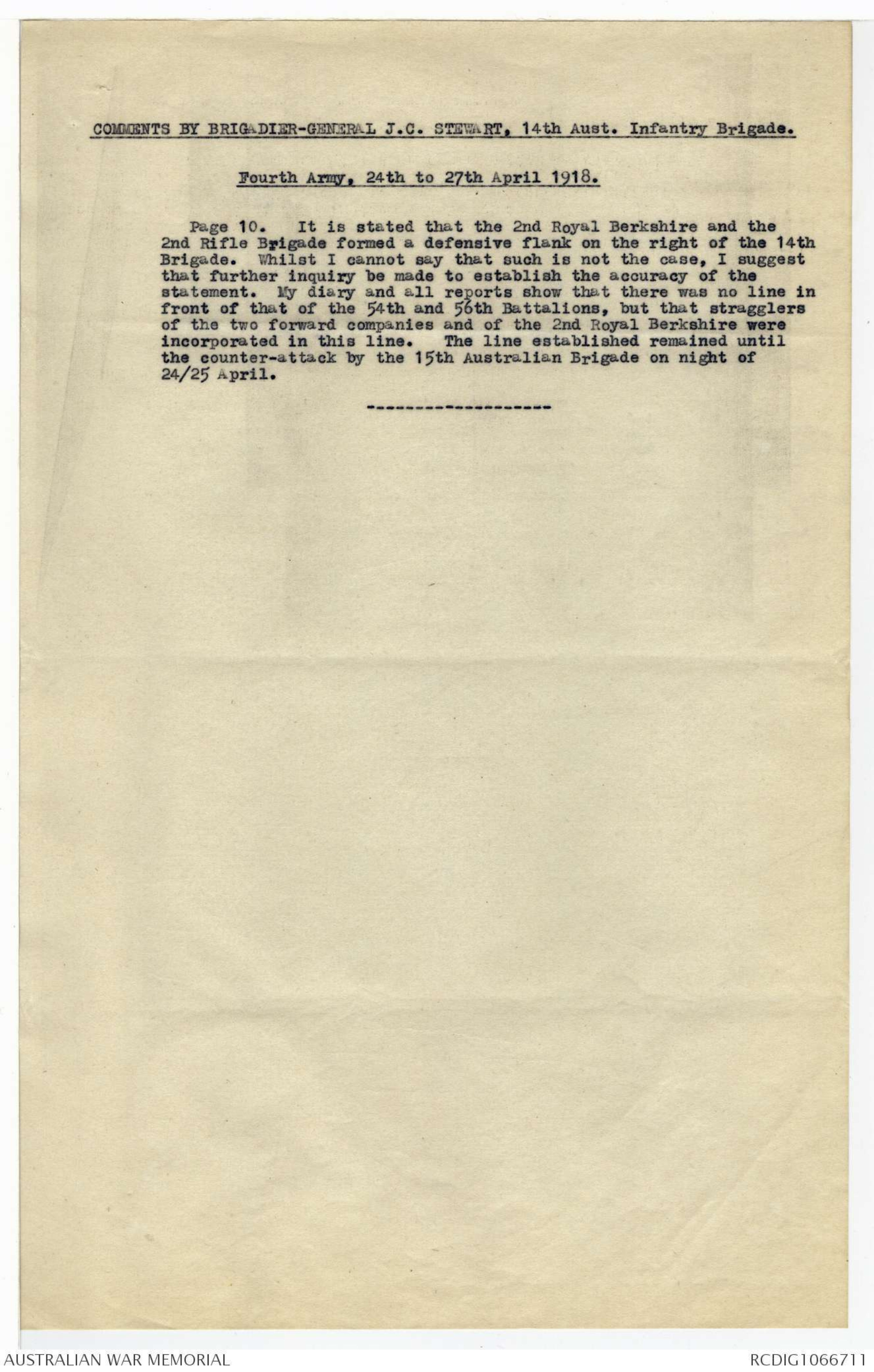
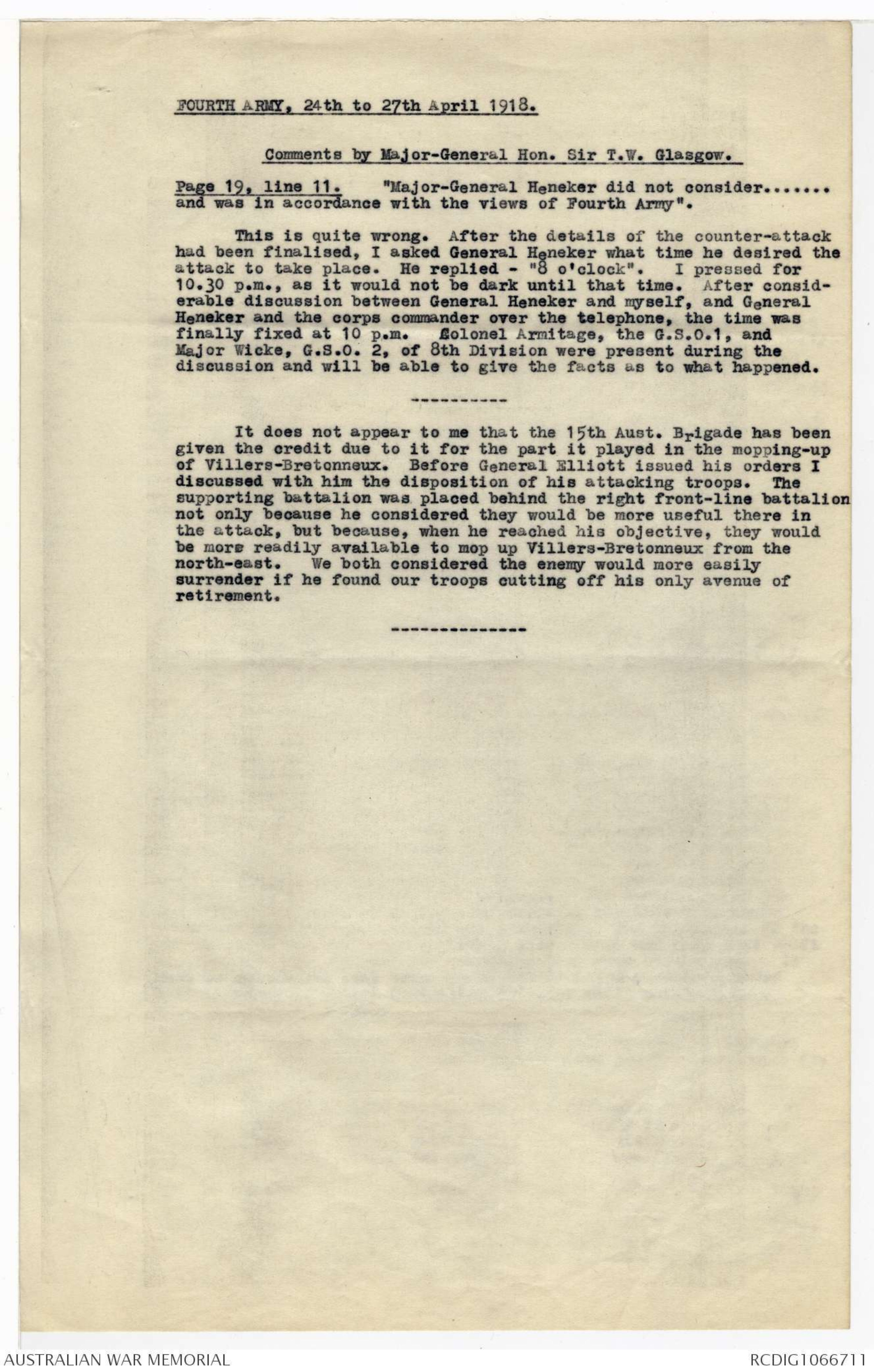
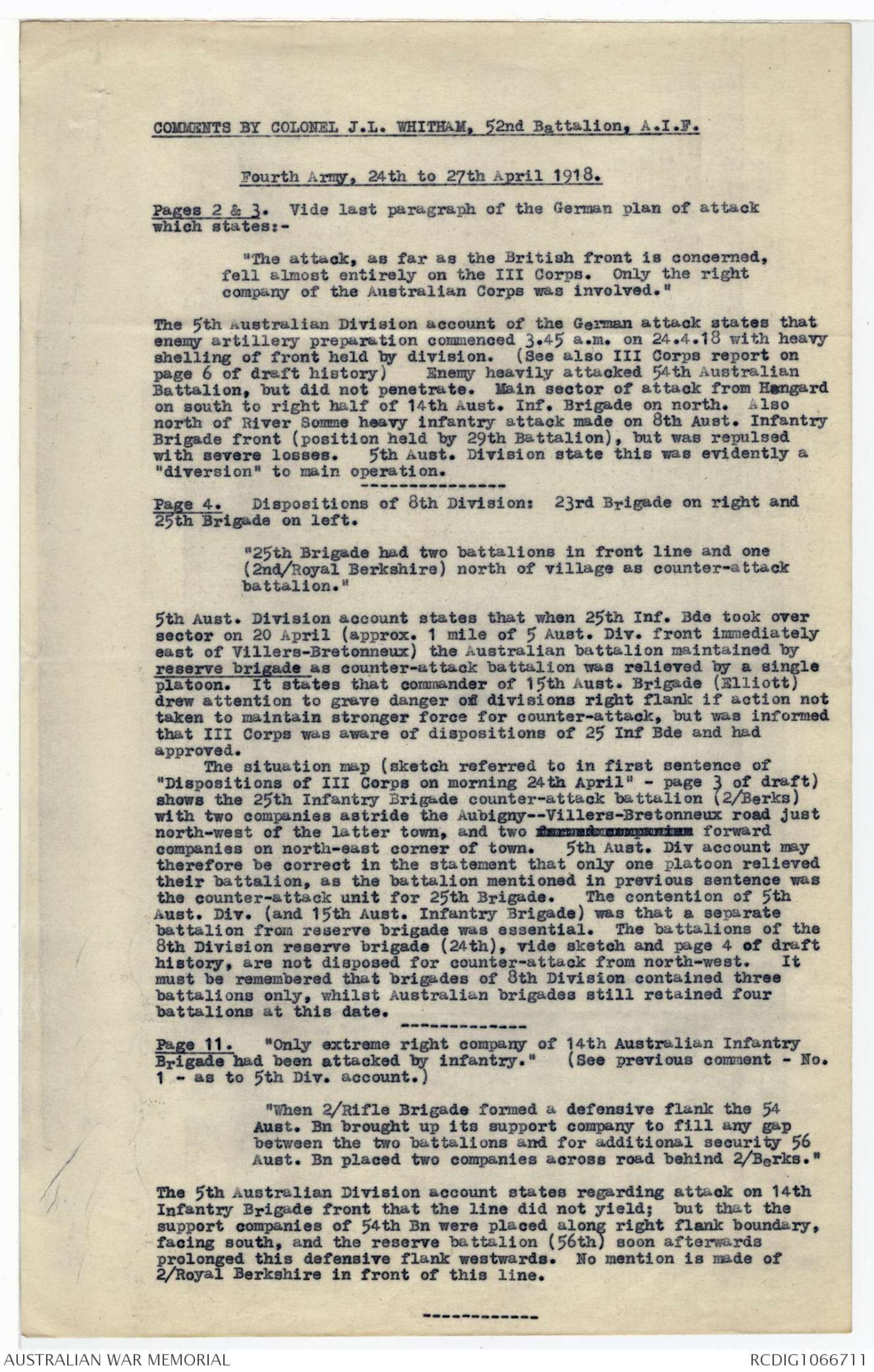
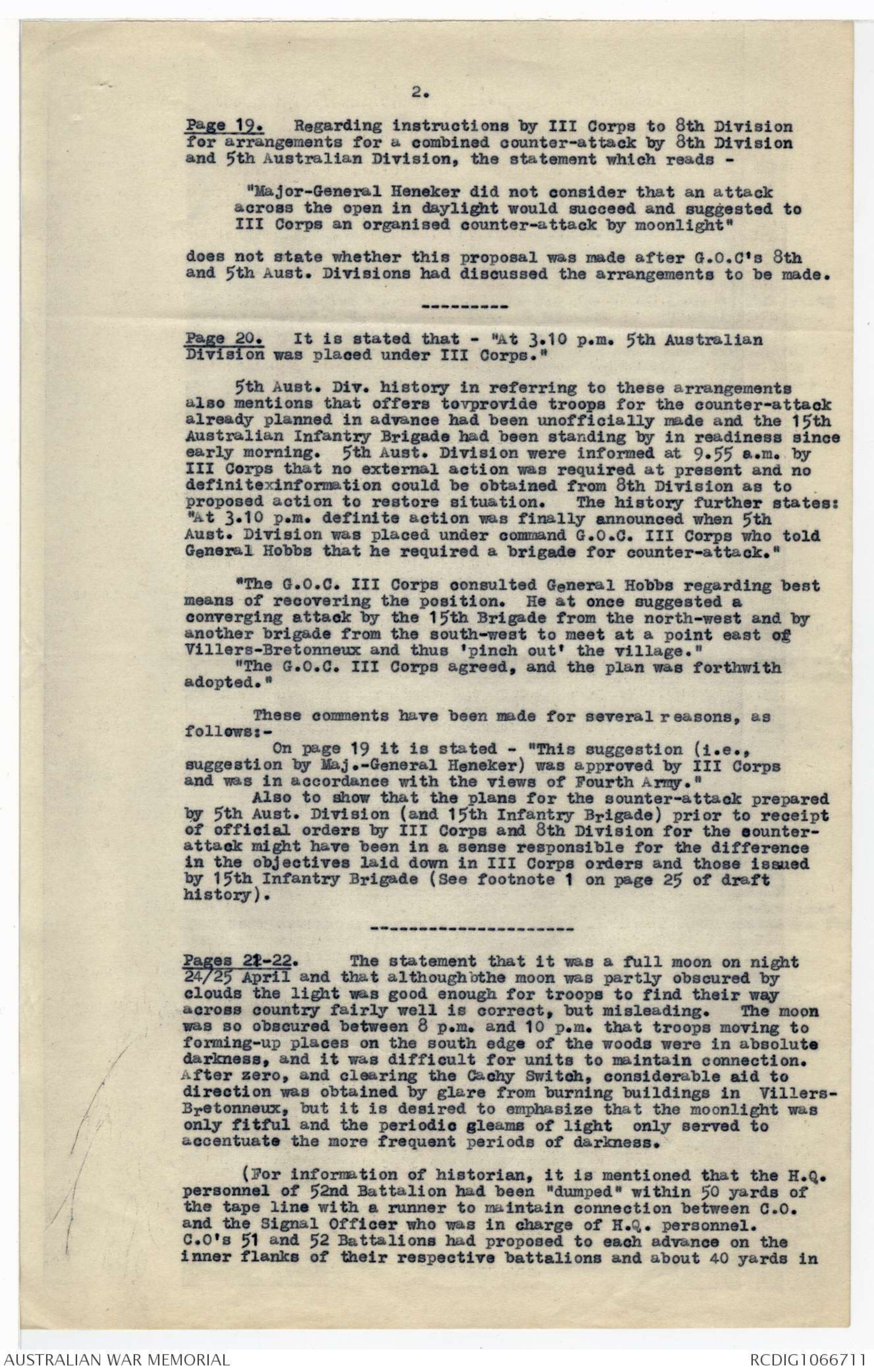
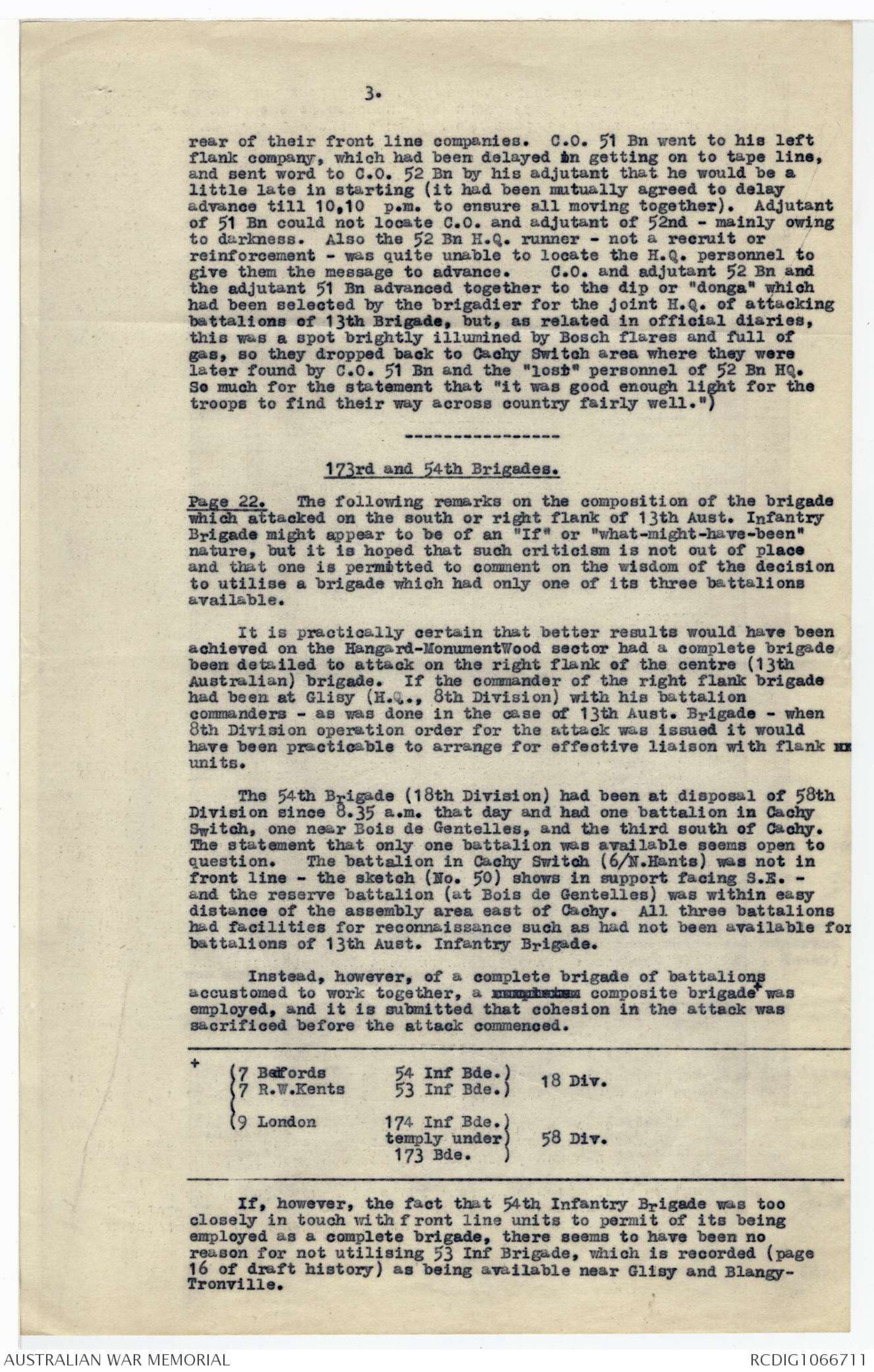
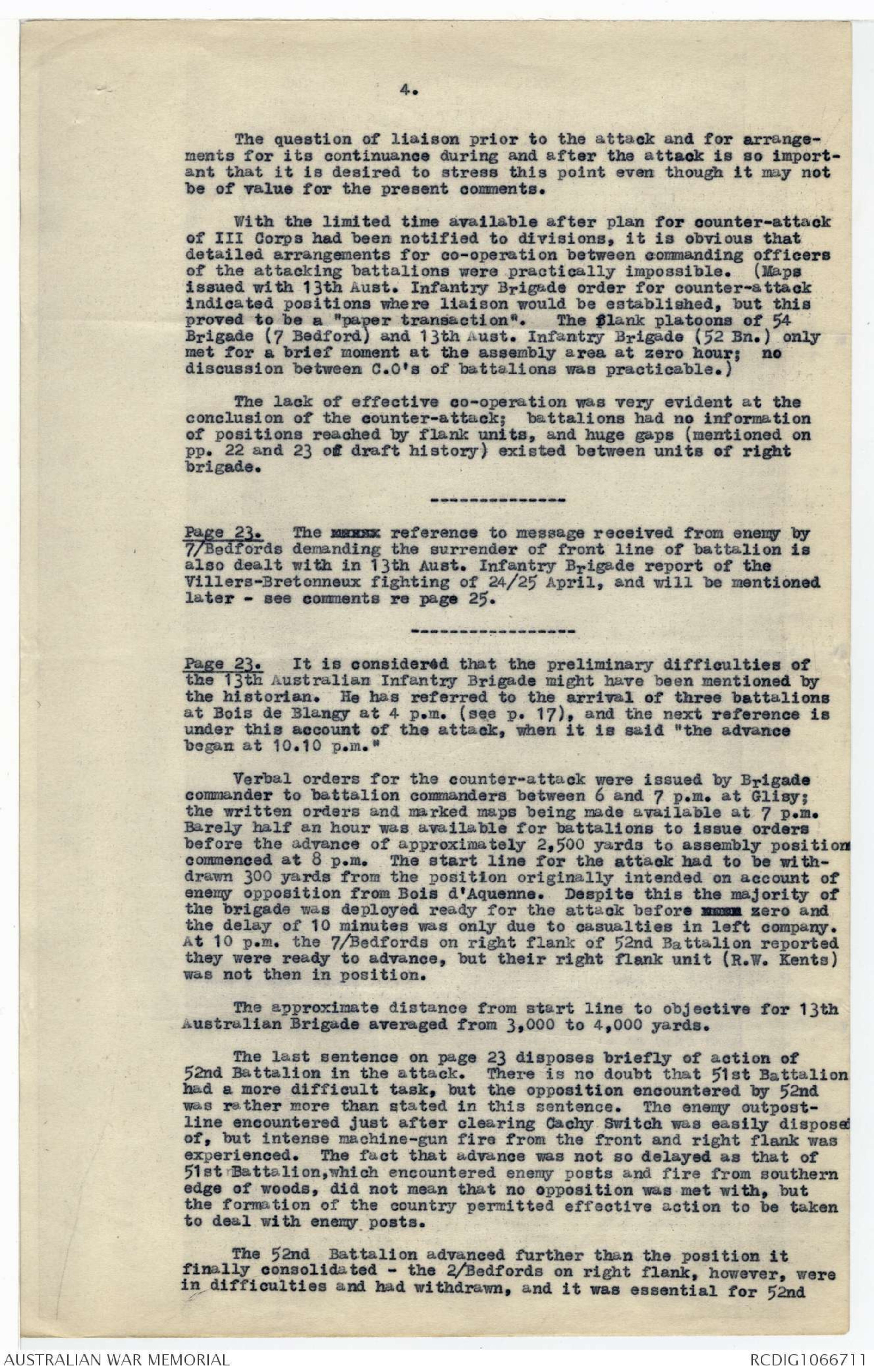
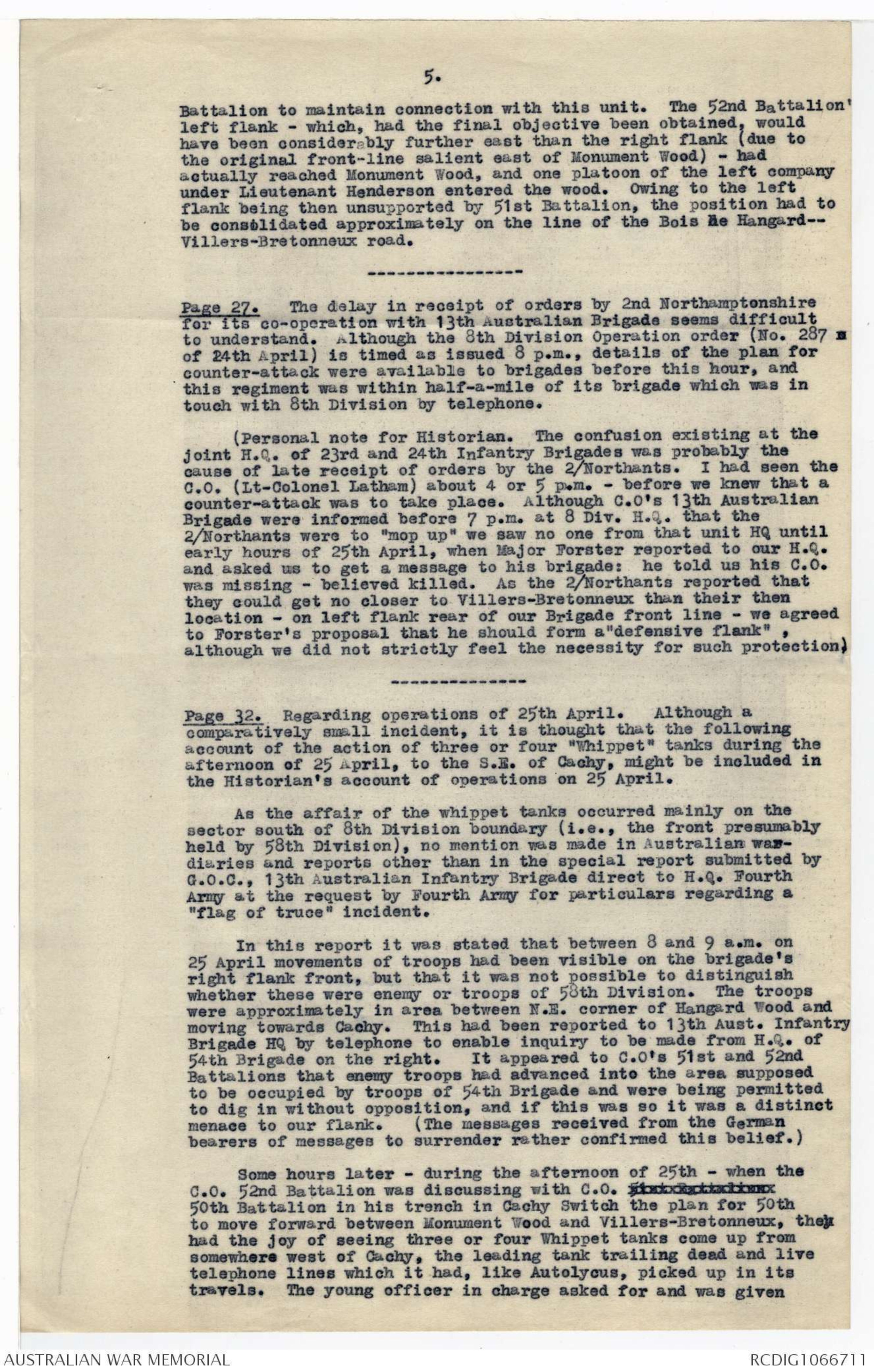
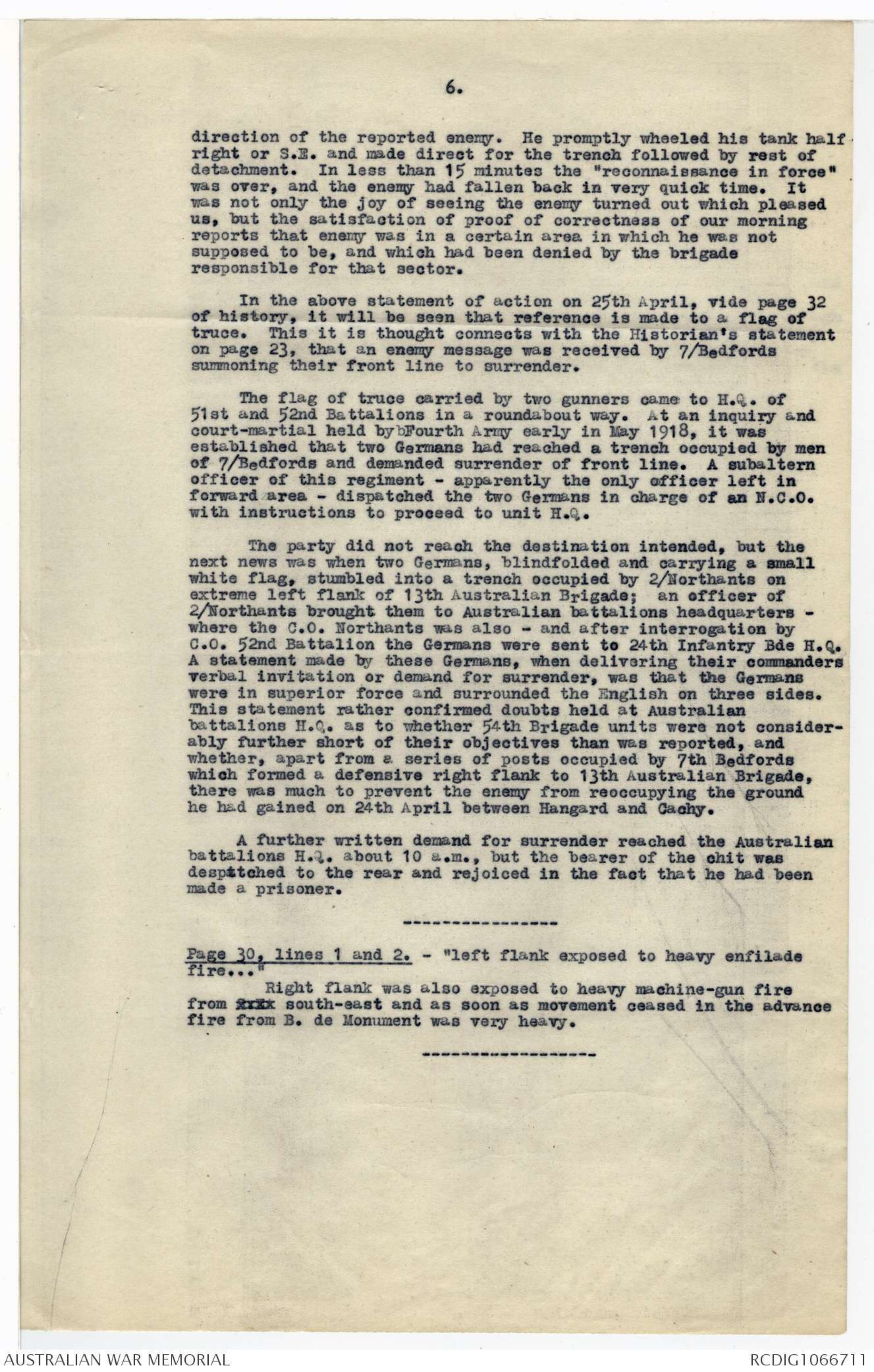
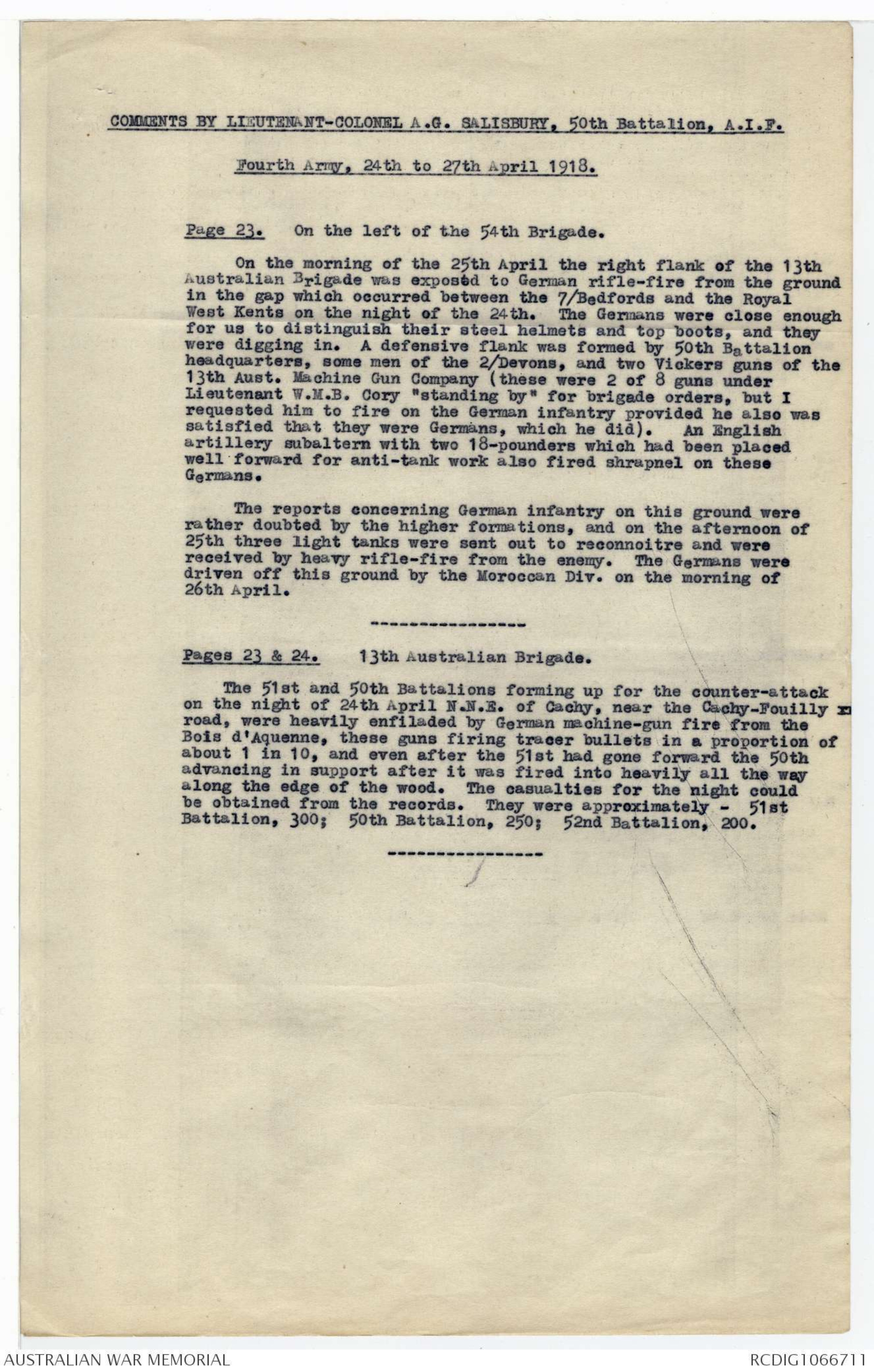
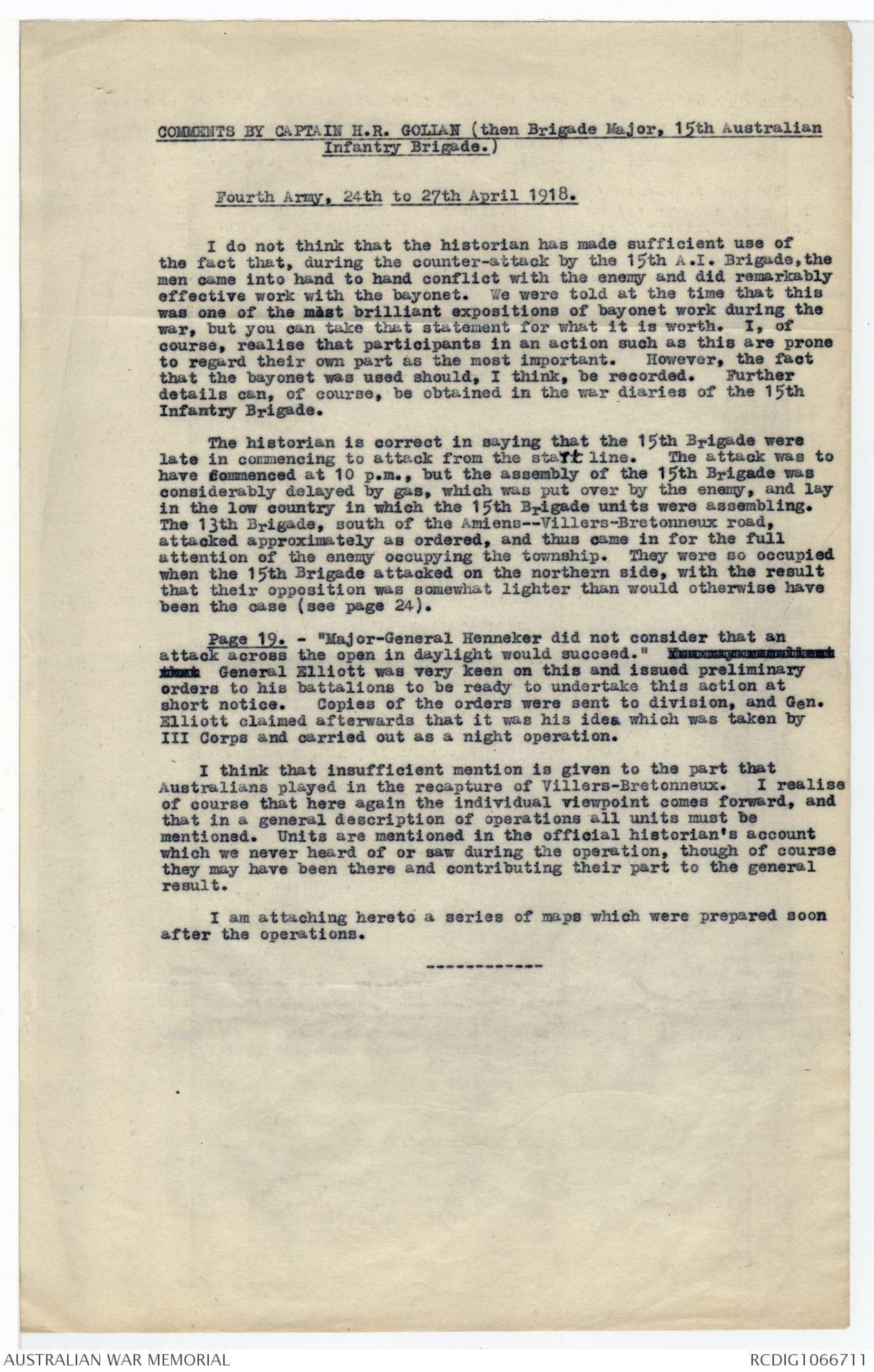
COMMENTS BY BRIGADIER-GENERAL J.C. STEWART, 14th Aust. Infantry Brigade.
Fourth Army, 24th to 27th April 1918.
Page 10. It is stated that the 2nd Royal Berkshire and the
2nd Rifle Brigade formed a defensive flank on the right of the 14th
Brigade. Whilst I cannot say that such is not the case, I suggest
that further inquiry be made to establish the accuracy of the
statement. My diary and all reports show that there was no line in
front of that of the 54th and 56th Battalions, but that stragglers
of the two forward companies and of the 2nd Royal Berkshire were
incorporated in this line. The line established remained until
the counter-attack by the 15th Australian Brigade on night of
24/25 April.
FOURTH ARMY, 24th to 27th April 1918.
Comments by Major-General Hon. Sir T.W. Glasgow.
Page 19, line 11. "Major-General Heneker did not consider.......
and was in accordance with the views of Fourth Army".
This is quite wrong. After the details of the counter-attack
had been finalised, I asked General Heneker what time he desired the
attack to take place. He replied - "8 o'clock". I pressed for
10.30 p.m., as it would not be dark until that time. After considerable
discussion between General Heneker and myself, and General
Heneker and the corps commander over the telephone, the time was
finally fixed at 10 p.m. Colonel Armitage, the G.S.O.1, and
Major Wicke, G.S.O. 2, of 8th Division were present during the
discussion and will be able to give the facts as to what happened.
It does not appear to me that the 15th Aust. Brigade has been
given the credit due to it for the part it played in the mopping-up
of Villers-Bretonneux. Before General Elliott issued his orders I
discussed with him the disposition of his attacking troops. The
supporting battalion was placed behind the right front-line battalion
not only because he considered they would be more useful there in
the attack, but because, when he reached his objective, they would
be more readily available to mop up Villers-Bretonneux from the
north-east. We both considered the enemy would more easily
surrender if he found our troops cutting off his only avenue of
retirement.
COMMENTS BY COLONEL J.L. WHITHAM, 52nd Battalion, A.I.F.
Fourth Army, 24th to 27th April 1918.
Pages 2 & 3. Vide last paragraph of the German plan of attack
which states:-
"The attack, as far as the British front is concerned,
fell almost entirely on the III Corps. Only the right
company of the Australian Corps was involved."
The 5th Australian Division account of the German attack states that
enemy artillery preparation commenced 3.45 a.m. on 24.4.18 with heavy
shelling of front held by division. (See also III Corps report on
page 6 of draft history ) Enemy heavily attacked 54th Australian
Battalion, but did not penetrate. Main sector of attack from Hangard
on south to right half of 14th Aust. Inf. Brigade on north. Also
north of River Somme heavy infantry attack made on 8th Aust. Infantry
Brigade front (position held by 29th Battalion), but was repulsed
with severe losses. 5th Aust. Division state this was evidently a
"diversion" to main operation.
Page 4. Dispositions of 8th Division: 23rd Brigade on right and
25th Brigade on left.
"25th Brigade had two battalions in front line and one
(2nd/Royal Berkshire) north of village as counter-attack
battalion."
5th Aust. Division account states that when 25th Inf. Bde took over
sector on 20 April (approx. 1 mile of 5 Aust. Div. front immediately
east of Villers-Bretonneux) the Australian battalion maintained by
reserve brigade as counter-attack battalion was relieved by a single
platoon. It states that commander of 15th Aust. Brigade (Elliott)
drew attention to grave danger of divisions right flank if action not
taken to maintain stronger force for counter-attack, but was informed
that III Corps was aware of dispositions of 25 Inf Bde and had
approved.
The situation map (sketch referred to in first sentence of
"Dispositions of III Corps on morning 24th April" - page 3 of draft)
shows the 25th Infantry Brigade counter-attack battalion (2/Berks)
with two companies astride the Aubigny--Villers-Bretonneux road just
north-west of the latter town, and two formed companies forward
companies on north-east corner of town. 5th Aust. Div account may
therefore be correct in the statement that only one platoon relieved
their battalion, as the battalion mentioned in previous sentence was
the counter-attack unit for 25th Brigade. The contention of 5th
Aust. Div. (and 15th Aust. Infantry Brigade) was that a separate
battalion from reserve brigade was essential. The battalions of the
8th Division reserve brigade (24th), vide sketch and page 4 of draft
history, are not disposed for counter-attack from north-west. It
must be remembered that brigades of 8th Division contained three
battalions only, whilst Australian brigades still retained four
battalions at this date.
Page 11. "Only extreme right company of 14th Australian Infantry
Brigade had been attacked by infantry." (See previous comment - No.
1 - as to 5th Div. account.)
"When 2/Rifle Brigade formed a defensive flank the 54
Aust. Bn brought up its support company to fill any gap
between the two battalions and for additional security 56
Aust. Bn placed two companies across road behind 2/Berks."
The 5th Australian Division account states regarding attack on 14th
Infantry Brigade front that the line did not yield; but that the
support companies of 54th Bn were placed along right flank boundary,
facing south, and the reserve battalion (56th) soon afterwards
prolonged this defensive flank westwards. No mention is made of
2/Royal Berkshire in front of this line.
2.
Page 19.
Regarding instructions by III Corps to 8th Division
for arrangements for a combined counter-attack by 8th Division
and 5th Australian Division, the statement which reads -
"Major-General Heneker did not consider that an attack
across the open in daylight would succeed and suggested to
III Corps an organised counter-attack by moonlight"
does not state whether this proposal was made after G.O.C's 8th
and 5th Aust. Divisions had discussed the arrangements to be made.
Page 20. It is stated that - "At 3.10 p.m. 5th Australian
Division was placed under III Corps."
5th Aust. Div. history in referring to these arrangements
also mentions that offers tovprovide troops for the counter-attack
already planned in advance had been unofficially made and the 15th
Australian Infantry Brigade had been standing by in readiness since
early morning. 5th Aust. Division were informed at 9.55 a.m. by
III Corps that no external action was required at present and no
definitexinformation could be obtained from 8th Division as to
proposed action to restore situation. The history further states:
"At 3.10 p.m. definite action was finally announced when 5th
Aust. Division was placed under command G.O.C. III Corps who told
General Hobbs that he required a brigade for counter-attack."
"The G.O.C. III Corps consulted General Hobbs regarding best
means of recovering the position. He at once suggested a
converging attack by the 15th Brigade from the north-west and by
another brigade from the south-west to meet at a point east of
Villers-Bretonneux and thus 'pinch out' the village."
"The G.O.C. III Corps agreed, and the plan was forthwith
adopted."
These comments have been made for several reasons, as
follows:-
On page 19 it is stated - "This suggestion (i.e.,
suggestion by Maj.-General Heneker) was approved by III Corps
and was in accordance with the views of Fourth Army."
Also to show that the plans for the sounter-attack prepared
by 5th Aust. Division (and 15th Infantry Brigade) prior to receipt
of official orders by III Corps and 8th Division for the counter-attack
might have been in a sense responsible for the difference
in the objectives laid down in III Corps orders and those issued
by 15th Infantry Brigade (See footnote 1 on page 25 of draft
history).
Pages 21-22. The statement that it was a full moon on night
24/25 April and that althoughbthe moon was partly obscured by
clouds the light was good enough for troops to find their way
across country fairly well is correct, but misleading. The moon
was so obscured between 8 p.m. and 10 p.m. that troops moving to
forming-up places on the south edge of the woods were in absolute
darkness, and it was difficult for units to maintain connection.
After zero, and clearing the Cachy Switch, considerable aid to
direction was obtained by glare from burning buildings in Villers-Bretonneux, but it is desired to emphasize that the moonlight was
only fitful and the periodic gleams of light only served to
accentuate the more frequent periods of darkness.
(For information of historian, it is mentioned that the H.Q.
personnel of 52nd Battalion had been "dumped" within 50 yards of
the tape line with a runner to maintain connection between C.O.
and the Signal Officer who was in charge of H.Q. personnel.
C.O's 51 and 52 Battalions had proposed to each advance on the
inner flanks of their respective battalions and about 40 yards in
3.
rear of their front line companies. C.O. 51 Bn went to his left
flank company, which had been delayed in getting on to tape line,
and sent word to C.O. 52 Bn by his adjutant that he would be a
little late in starting (it had been mutually agreed to delay
advance till 10.10 p.m. to ensure all moving together). Adjutant
of 51 Bn could not locate C.O. and adjutant of 52nd - mainly owing
to darkness. Also the 52 Bn H.Q. runner - not a recruit or
reinforcement - was quite unable to locate the H.Q. personnel to
give them the message to advance. C.O. and adjutant 52 Bn and
the adjutant 51 Bn advanced together to the dip or "donga" which
had been selected by the brigadier for the joint H.Q. of attacking
battalions of 13th Brigade, but, as related in official diaries,
this was a spot brightly illumined by Bosch flares and full of
gas, so they dropped back to Cachy Switch area where they were
later found by C.O. 51 Bn and the "lost" personnel of 52 Bn HQ.
So much for the statement that "it was good enough light for the
troops to find their way across country fairly well.")
173rd and 54th Brigades.
Page 22. The following remarks on the composition of the brigade
which attacked on the south or right flank of 13th Aust. Infantry
Brigade might appear to be of an "If" or "what-might-have-been"
nature, but it is hoped that such criticism is not out of place
and that one is permitted to comment on the wisdom of the decision
to utilise a brigade which had only one of its three battalions
available.
It is practically certain that better results would have been
achieved on the Hangard-MonumentWood sector had a complete brigade
been detailed to attack on the right flank of the centre (13th
Australian) brigade. If the commander of the right flank brigade
had been at Glisy (H.Q., 8th Division) with his battalion
commanders - as was done in the case of 13th Aust. Brigade - when
8th Division operation order for the attack was issued it would
have been practicable to arrange for effective liaison with flank xx
units.
The 54th Brigade (18th Division) had been at disposal of 58th
Division since 8.35 a.m. that day and had one battalion in Cachy
Switch, one near Bois de Gentelles, and the third south of Cachy.
The statement that only one battalion was available seems open to
question. The battalion in Cachy Switch (6/N.Hants) was not in
front line - the sketch (No. 50) shows in support facing S.E.-
and the reserve battalion (at Bois de Gentelles) was within easy
distance of the assembly area east of Cachy. All three battalions
had facilities for reconnaissance such as had not been available for
battalions of 13th Aust. Infantry Brigade.
Instead, however, of a complete brigade of battalions
accustomed to work together, a complete composite brigade+ was
employed, and it is submitted that cohesion in the attack was
sacrificed before the attack commenced.
+(7 Befords 54 Inf Bde.)
(7 R.W.Kents 53 Inf Bde.) 18 Div.
(9 London 174 Inf Bde.)
temply under) 58 Div.
173 Bde.)
If, however, the fact that 54th Infantry Brigade was too
closely in touch with front line units to permit of its being
employed as a complete brigade, there seems to have been no
reason for not utilising 53 Inf Brigade, which is recorded (page
16 of draft history) as being available near Glisy and Blangy-Tronville.
4.
The question of liaison prior to the attack and for arrangements
for its continuance during and after the attack is so important
that it is desired to stress this point even though it may not
be of value for the present comments.
With the limited time available after plan for counter-attack
of III Corps had been notified to divisions, it is obvious that
detailed arrangements for co-operation between commanding officers
of the attacking battalions were practically impossible. (Maps
issued with 13th Aust. Infantry Brigade order for counter-attack
indicated positions where liaison would be established, but this
proved to be a "paper transaction". The flank platoons of 54
Brigade (7 Bedford) and 13th Aust. Infantry Brigade (52 Bn.) only
met for a brief moment at the assembly area at zero hour; no
discussion between C.O's of battalions was practicable.)
The lack of effective co-operation was very evident at the
conclusion of the counter-attack; battalions had no information
of positions reached by flank units, and huge gaps (mentioned on
pp. 22 and 23 of draft history) existed between units of right
brigade.
Page 23. The xxxxx reference to message received from enemy by
7/Bedfords demanding the surrender of front line of battalion is
also dealt with in 13th Aust. Infantry Brigade report of the
Villers-Bretonneux fighting of 24/25 April, and will be mentioned
later - see comments re page 25.
Page 23. It is considered that the preliminary difficulties of
the 13th Australian Infantry Brigade might have been mentioned by
the historian. He has referred to the arrival of three battalions
at Bois de Blangy at 4 p.m. (see p. 17), and the next reference is
under this account of the attack, when it is said "the advance
began at 10.10 p.m."
Verbal orders for the counter-attack were issued by Brigade
commander to battalion commanders between 6 and 7 p.m. at Glisy;
the written orders and marked maps being made available at 7 p.m.
Barely half an hour was available for battalions to issue orders
before the advance of approximately 2,500 yards to assembly position
commenced at 8 p.m. The start line for the attack had to be withdrawn
300 yards from the position originally intended on account of
enemy opposition from Bois d'Aquenne. Despite this the majority of
the brigade was deployed ready for the attack before xxxx zero and
the delay of 10 minutes was only due to casualties in left company.
At 10 p.m. the 7/Bedfords on right flank of 52nd Battalion reported
they were ready to advance, but their right flank unit (R.W. Kents)
was not then in position.
The approximate distance from start line to objective for 13th
Australian Brigade averaged from 3,000 t0 4,000 yards.
The last sentence on page 23 disposes briefly of action of
52nd Battalion in the attack. There is no doubt that 51st Battalion
had a more difficult task, but the opposition encountered by 52nd
was rather more than stated in this sentence. The enemy outpost-line
encountered just after clearing Cachy Switch was easily disposed
of, but intense machine-gun fire from the front and right flank was
experienced. The fact that advance was not so delayed as that of
51st Battalion, which encountered enemy posts and fire from southern
edge of woods, did not mean that no opposition was met with, but
the formation of the country permitted effective action to be taken
to deal with enemy posts.
The 52nd Battalion advanced further than the position it
finally consolidated - the 2/Bedfords on right flank, however, were
in difficulties and had withdrawn, and it was essential for 52nd
5.
Battalion to maintain connection with this unit. The 52nd Battalion'
left flank - which, had the final objective been obtained, would
have been considerably further east than the right flank (due to
the original front-line salient east of Monument Wood) - had
actually reached Monument Wood, and one platoon of the left company
under Lieutenant Henderson entered the wood. Owing to the left
flank being then unsupported by 51st Battalion, the position had to
be consolidated approximately on the line of the Bois de Hangard--
Villers-Bretonneux road.
Page 27. The delay in receipt of orders by 2nd Northamptonshire
for its co-operation with 13th Australian Brigade seems difficult
to understand. Although the 8th Division Operation order (No. 287 x
of 24th April) is timed as issued 8 p.m., details of the plan for
counter-attack were available to brigades before this hour, and
this regiment was within half-a-mile of its brigade which was in
touch with 8th Division by telephone.
(Personal note for Historian. The confusion existing at the
joint H.Q. of 23rd and 24th Infantry Brigades was probably the
cause of late receipt of orders by the 2/Northants. I had seen the
C.O. (Lt-Colonel Latham) about 4 or 5 p.m. - before we knew that a
counter-attack was to take place. Although C.O's 13th Australian
Brigade were informed before 7 p.m. at 8 Div. H.Q. that the
2/Northants were to "mop up" we saw no one from that unit HQ until
early hours of 25th April, when Major Forster reported to our H.Q.
and asked us to get a message to his brigade: he told us his C.O.
was missing - believed killed. As the 2/Northants reported that
they could get no closer to Villers-Bretonneux than their then
location - on left flank rear of our Brigade front line - we agreed
to Forster's proposal that he should form a "defensive flank",
although we did not strictly feel the necessity for such protection)
Page 32. Regarding operations of 25th April. Although a
comparatively small incident, it is thought that the following
account of the action of three or four "Whippet" tanks during the
afternoon of 25 April, to the S.E. of Cachy, might be included in
the Historian's account of operations on 25 April.
As the affair of the whippet tanks occurred mainly on the
sector south of 8th Division boundary (i.e., the front presumably
held by 58th Division), no mention was made in Australian war-diaries
and reports other than in the special report submitted by
G.O.C., 13th Australian Infantry Brigade direct to H.Q. Fourth
Army at the request by Fourth Army for particulars regarding a
"flag of truce" incident.
In this report it was stated that between 8 and 9 a.m. on
25 April movements of troops had been visible on the brigade's
right flank front, but that it was not possible to distinguish
whether these were enemy or troops of 58th Division. The troops
were approximately in area between N.E. corner of Hangard Wood and
moving towards Cachy. This had been reported to 13th Aust. Infantry
Brigade HQ by telephone to enable inquiry to be made from H.Q. of
54th Brigade on the right. It appeared to C.O's 51st and 52nd
Battalions that enemy troops had advanced into the area supposed
to be occupied by troops of 54th Brigade and were being permitted
to dig in without opposition, and if this was so it was a distinct
menace to our flank. (The messages received from the German
bearers of messages to surrender rather confirmed this belief.)
Some hours later - during the afternoon of 25th - when the
C.O. 52nd Battalion was discussing with C.O. 51st Battalion
50th Battalion in his trench in Cachy Switch the plan for 50th
to move forward between Monument Wood and Villers-Bretonneux, they
had the joy of seeing three or four Whippet tanks come up from
somewhere west of Cachy, the leading tank trailing dead and live
telephone lines which it had, like Autolycus, picked up in its
travels. The young officer in charge asked for and was given
6.
direction of the reported enemy. He promptly wheeled his tank half
right or S.E. and made direct for the trench followed by rest of
detachment. In less than 15 minutes the "reconnaissance in force"
was over, and the enemy had fallen back in very quick time. It
was not only the joy of seeing the enemy turned out which pleased
us, but the satisfaction of proof of correctness of our morning
reports that enemy was in a certain area in which he was not
supposed to be, and which had been denied by the brigade
responsible for that sector.
In the above statement of action on 25th April, vide page 32
of history, it will be seen that reference is made to a flag of
truce. This it is thought connects with the Historian's statement
on page 23, that an enemy message was received by 7/Bedfords
summoning their front line to surrender.
The flag of truce carried by two gunners came to H.Q. of
51st and 52nd Battalions in a roundabout way. At an inquiry and
court-martial held bybFourth Army early in May 1918, it was
established that two Germans had reached a trench occupied by men
of 7/Bedfords and demanded surrender of front line. A subaltern
officer of this regiment - apparently the only officer left in
forward area - dispatched the two Germans in charge of an N.C.O.
with instructions to proceed to unit H.Q.
The party did not reach the destination intended, but the
next news was when two Germans, blindfolded and carrying a small
white flag, stumbled into a trench occupied by 2/Northants on
extreme left flank of 13th Australian Brigade; an officer of
2/Northants brought them to Australian battalions headquarters -
where the C.O. Northants was also - and after interrogation by
C.O. 52nd Battalion the Germans were sent to 24th Infantry Bde H.Q.
A statement made by these Germans, when delivering their commanders
verbal invitation or demand for surrender, was that the Germans
were in superior force and surrounded the English on three sides.
This statement rather confirmed doubts held at Australian
battalions H.Q. as to whether 54th Brigade units were not considerably
further short of their objectives than was reported, and
whether, apart from a series of posts occupied by 7th Bedfords
which formed a defensive right flank to 13th Australian Brigade,
there was much to prevent the enemy from reoccupying the ground
he had gained on 24th April between Hangard and Cachy.
A further written demand for surrender reached the Australian
battalions H.Q. about 10 a.m., but the bearer of the chit was
despttched to the rear and rejoiced in the fact that he had been
made a prisoner.
Page 30, lines 1 and 2. - "left flank exposed to heavy enfilade
fire..."
Right flank was also exposed to heavy machine-gun fire
from xxxx south-east and as soon as movement ceased in the advance
fire from B. de Monument was very heavy.
COMMENTS BY LIEUTENANT-COLONEL A.G. SALISBURY, 50th Battalion, A.I.F.
Fourth Army, 24th to 27th April 1918.
Page 23. On the left of the 54th Brigade.
On the morning of the 25th April the right flank of the 13th
Australian Brigade was exposed to German rifle-fire from the ground
in the gap which occurred between the 7/Bedfords and the Royal
West Kents on the night of the 24th. The Germans were close enough
for us to distinguish their steel helmets and top boots, and they
were digging in. A defensive flank was formed by 50th Battalion
headquarters, some men of the 2/Devons, and two Vickers guns of the
13th Aust. Machine Gun Company (these were 2 of 8 guns under
Lieutenant W.M.B. Cory "standing by" for brigade orders, but I
requested him to fire on the German infantry provided he also was
satisfied that they were Germans, which he did). An English
artillery subaltern with two 18-pounders which had been placed
well forward for anti-tank work also fired shrapnel on these
Germans.
The reports concerning German infantry on this ground were
rather doubted by the higher formations, and on the afternoon of
25th three light tanks were sent out to reconnoitre and were
received by heavy rifle-fire from the enemy. The Germans were
driven off this ground by the Moroccan Div. on the morning of
26th April.
Pages 23 & 24. 13th Australian Brigade.
The 51st and 50th Battalions forming up for the counter-attack
on the night of 24th April N.N.E. of Cachy, near the Cachy-Fouilly xx
road, were heavily enfiladed by German machine-gun fire from the
Bois d'Aquenne, these guns firing tracer bullets in a proportion of
about 1 in 10, and even after the 51st had gone forward the 50th
advancing in support after it was fired into heavily all the way
along the edge of the wood. The casualties for the night could
be obtained from the records. They were approximately - 51st
Battalion, 300; 50th Battalion, 250; 52nd Battalion, 200.
COMMENTS BY CAPTAIN H.R. GOLIAN (then Brigade Major, 15th Australian
Infantry Brigade.)
Fourth Army, 24th to 27th April 1918.
I do not think that the historian has made sufficient use of
the fact that, during the counter-attack by the 15th A.I. Brigade, the
men came into hand to hand conflict with the enemy and did remarkably
effective work with the bayonet. We were told at the time that this
was one of the most brilliant expositions of bayonet work during the
war, but you can take that statement for what it is worth. I, of
course, realise that participants in an action such as this are prone
to regard their own part as the most important. However, the fact
that the bayonet was used should, I think, be recorded. Further
details can, of course, be obtained in the war diaries of the 15th
Infantry Brigade.
The historian is correct in saying that the 15th Brigade were
late in commencing to attack from the start line. The attack was to
have commenced at 10 p.m., but the assembly of the 15th Brigade was
considerably delayed by gas, which was put over by the enemy, and lay
in the low country in which the 15th Brigade units were assembling.
The 13th Brigade, south of the Amiens--Villers-Bretonneux road,
attacked approximately as ordered, and thus came in for the full
attention of the enemy occupying the township. They were so occupied
when the 15th Brigade attacked on the northern side, with the result
that their opposition was somewhat lighter than would otherwise have
been the case (see page 24).
Page 19. - "Major-General Henneker did not consider that an
attack across the open in daylight would succeed." You may excellentthat General Elliott was very keen on this and issued preliminary
orders to his battalions to be ready to undertake this action at
short notice. Copies of the orders were sent to division, and Gen.
Elliott claimed afterwards that it was his idea which was taken by
III Corps and carried out as a night operation.
I think that insufficient mention is given to the part that
Australians played in the recapture of Villers-Bretonneux. I realise
of course that here again the individual viewpoint comes forward, and
that in a general description of operations all units must be
mentioned. Units are mentioned in the official historian's account
which we never heard of or saw during the operation, though of course
they may have been there and contributing their part to the general
result.
I am attaching heretó a series of maps which were prepared soon
after the operations.
 Diane Ware
Diane WareThis transcription item is now locked to you for editing. To release the lock either Save your changes or Cancel.
This lock will be automatically released after 60 minutes of inactivity.